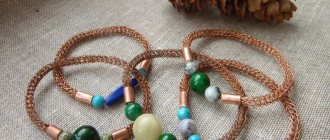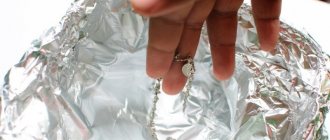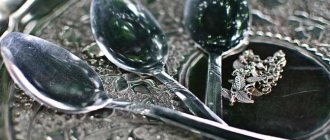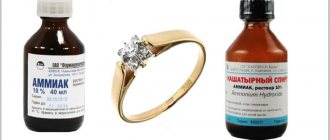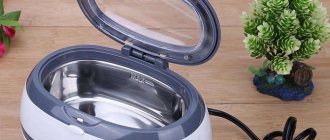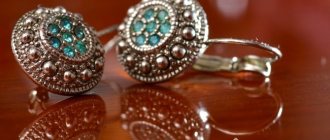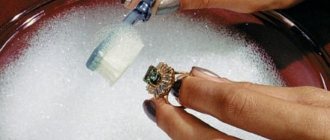What causes tarnishing or, even worse, blackening of silver? Items made of this metal can darken, relying on extrasensory perception, when the wearer of the item is under the evil eye or damage. Many will not even consider such an explanation, considering the superstition absurd. Meanwhile, there are more banal and mundane reasons, from a chemical point of view, for the darkening of silver items.
Why does silver darken?
Unlike gold, silver turns black faster: if it is enough to clean gold once a year or even less often, in order for silver items to be shiny and sparkling, they must be cleaned of plaque at least once every two months (the less often this is done, the thicker the plaque will be and darker color).
The lower the quality of the silver, the more effort is required to clean it, so when purchasing, it is advisable to give preference to 925 sterling silver (the purest silver is 999 sterling silver, but it is not used in manufacturing because it is very fragile and brittle).
The main reason that affects the darkening of silver and gold is the presence of various impurities in the metal, primarily copper, which oxidize when interacting with other substances, which manifests itself in the form of a black coating. For example, if we talk about silver jewelry, then when worn, copper reacts with sulfur, which is part of sweat, as a result of which silver sulfide appears in the form of black crystals on the surface of the silver.
Silver jewelry also often darkens in people who have problems with stomach acidity. For this reason, jewelry with a smooth surface is most often darkened, since it comes into close contact with the skin, providing maximum contact.
Another reason why silver darkens is the high sulfur content in the environment: the higher its concentration, the faster the product darkens. Can cause darkening of silver and its storage in conditions of high humidity.
Blackening of silver: what's the matter
Precious items that a person wears darken over time.
This happens due to the interaction of the metal with sweat, since the latter contains sulfur. This substance comes into contact with silver, causing the formation of sulfide. This process, it is easy to see, can be explained using chemistry. However, this is not all. 925 sterling silver products contain copper. The latter also oxidizes and a coating forms, but it is green in color and has an unpleasant aroma. This is especially evident when a person wears his favorite ring, almost never taking it off. In this case, the silver product is constantly exposed to external factors in the form of household chemicals, greasy dishes, etc.
After a while, when the ring is removed from the finger, the wearer notices greening, darkening or blackening. Of course, wearing such a product is unpleasant. Why did it happen that the ring looked decent when worn, but then suddenly oxidized? It turns out that when using silver products regularly, a person washes his hands quite often, which cleans the surface of the jewelry. But as soon as it is thrown onto the shelf without cleaning, various substances remain on it, and the latter slowly but surely interact with the copper. Consequently, that same annoying plaque appears.
Darkening of silver can be caused by:
- ordinary dust, dirt, soot that sticks tightly to silver jewelry due to subcutaneous fat;
- soot, varnish, wax, fat;
- soil, in particular among garden and plant lovers.
If you believe it, tarnished silver indicates a person’s illness or imminent illness. You can, of course, not believe in this, but there is some scientific justification for this superstition. Science says that as certain diseases develop, a person's sweat begins to release more sulfur. The latter interacts with the metal, and then we know what happens. Our silver ancestors made certain predictions regarding ailments in this way. Sometimes superstitions contain quite realistic implications, sometimes proven by scientific research.
Ammonia and silver
Ammonia effectively removes blackness from silver and gold due to its ability to react with any chemical oxidizing agent, converting it into ammonium salts, which allows it to be a very good solvent. At the same time, its peculiarity is that ammonia does not affect gold and silver when removing plaque, which allows it to be used without the risk of damaging the precious metal.
The only point that needs to be taken into account when cleaning is that you cannot soak silver and gold in the same solution, as they will react, resulting in yellow silver and white gold. It is not recommended to use ammonia to clean gold-plated silver, as well as items with pearls. For products that contain other precious stones, when preparing the solution, you need to reduce the amount of ammonia.
Rules for caring for silver
To prevent silver from darkening, the following rules should be followed:
- Put on jewelry only after the cosmetic oil or cream has been completely absorbed.
- Avoid storing silver in high humidity conditions.
- Remove jewelry when swimming, especially in salt water.
- It is advisable to store the products in a dry place; it is best to wrap them in foil.
- Remove chains and rings before dishwashing or hand washing.
- To prevent silver from oxidizing, it is recommended to place aluminum foil in the box.
- You can put chalk in the storage box to help maintain the shine.
- After removal, it is recommended to wipe the jewelry with a soft, dry cloth.
It is also important to periodically clean silver from plaque.
If you follow these recommendations, you can wear the jewelry longer, because it will turn black less.
Precautionary measures
When working with ammonia, given its characteristics as an excellent solvent and the presence of a pungent odor, we must not forget about precautions: the skin of the hands should in no case come into contact with the solution, since ammonia, being a solvent, can corrode the skin.
If the mixture accidentally ends up on it or on mucous membranes, you should immediately rinse the affected area with plenty of water, and then consult a doctor. Therefore, when cleaning the product, you must remember to wear rubber gloves; to remove the soaked product from the dish, you can use tweezers.
If it is necessary to clean tableware from blackness, it is advisable to replace ammonia with an alternative agent. If the product is poorly washed, the remains of ammonia may end up in the body and cause poisoning or burns.
One of the disadvantages of this method is the pungent odor, which is so dangerous that if you do not take precautions, inhaling the vapors can cause poisoning. Therefore, bending your head over an open bottle of ammonia, as well as breathing in vapors, is strictly not recommended. Fortunately, the unpleasant odor dissipates very quickly, so in order for the unpleasant odor to disappear as quickly as possible, cleaning should be carried out in a well-ventilated area.
Preparing the product for cleaning
To clean silver or gold with ammonia, you may need:
- Toothbrush;
- sponge, wool or flannel fabric (under no circumstances should you use abrasive substances or hard brushes to clean silver: they can scratch it and ruin the appearance of the product);
- a container for the solution (it should be borne in mind that it cannot subsequently be used for cooking);
- paper napkins;
- rubber gloves and tweezers.
The cleaning method largely depends on the product: if you need to clean, for example, a chain, you should take into account that it consists of many links, which are not easy to get to from all sides, so the best option would be to soak the product. Before you start cleaning the product with ammonia, it is advisable to soak it in a soap solution for a while: most of the blackness will come off and it will be easier to clean the precious metal.
What owners of silver jewelry need to remember
There are several rules with which you can extend the life of your silver jewelry. First of all, let's talk about cleaning. It is prohibited to use for it:
- hard brushes;
- abrasive compounds (coarse salt, cleaning products with granules);
- aggressive chemicals.
Since silver is a fairly soft metal, it is forbidden to perform physical work in rings made of it. In addition, it can change color under the influence of:
- onion or carrot juice;
- floor cleaning or surface cleaning products;
- components of decorative cosmetics, as well as skin care creams.
For this reason, it is recommended to remove jewelry before doing housework, cooking, or using cosmetics. Water procedures and bathing in jewelry are also not recommended. Often in silver items, decorative or functional elements are attached to steel wire, which rusts when exposed to moisture and breaks down. Due to high temperature and humidity, the skin begins to secrete particles that clog into the smallest pores of the jewelry, as a result of which it looks untidy.
Correct technique
When starting to clean silver with ammonia, you need to prepare a solution by diluting 1 tbsp. l. alcohol in 10 tbsp. l. water. After this, put silver items in the liquid and leave for at least half an hour (soaking time depends on how firmly the blackness is ingrained into the precious metal, but no more than an hour). When the time is up, wear gloves, remove the product from the solution and wipe with dry wipes.
If the coating is not strong, to get rid of the blackness, you can moisten a woolen or flannel cloth with ammonia (it is advisable not to bend over the bottle because of the pungent odor). After this, rub the blackened surface well.
You can rid silver items of blackness by mixing ammonia, hydrogen peroxide, baby liquid soap and water in equal proportions. After this, put the silver in the solution and wait the time necessary for the blackness to pass. Dry the cleaned product with napkins and polish with a woolen cloth.
In case of very severe contamination, you can use a pure ammonia solution. To do this, put the silver in the product for fifteen minutes, then remove it, rinse and dry. When cleaning silver using this method, you must act carefully and do not lean over the product, so as not to be poisoned by the smell of ammonia.
Ammonia and tooth powder
To make cleaning silver with ammonia more effective, you can prepare a solution with tooth powder. At the same time, you need to act carefully here, since there are recipes that cannot be used for products with stones, but there are also those that clean both silver and the elements decorating them well.
To prepare a solution for cleaning silver items with stones, you need to mix ammonia and tooth powder in equal quantities. After this, moisten flannel or woolen material in the mixture and clean the product. When the silver is cleared of blackness, rinse the product under running water, dry and polish.
There is another effective method that allows you to remove old plaque, however, this method is not suitable for cleaning products with stones:
- 5 tbsp. l. warm water;
- 1 tbsp. l. tooth powder (sold at the pharmacy);
- 2 tbsp. l. ammonia.
After mixing the components, moisten the sponge into the mixture and clean the product.
When the silver is clean, rinse with water and wipe dry. If it is not possible to get tooth powder, you can replace it with toothpaste.
To clean heavily soiled items, you need to apply toothpaste to a toothbrush, thoroughly clean the jewelry on all sides, and then place the silver in a ten percent ammonia solution for several minutes. Rinse the cleaned product under running water, dry well with paper towels and polish with wool, suede or flannel cloth.
How to clean silver items using ammonia at home
Ammonia is perhaps the most effective, inexpensive known method that allows you to quickly and efficiently clean a product from tarnishing or blackening. And although ammonia has long been known as a cleaning method, it is still in demand today. Among the huge number of modern special products that are designed for cleaning silver or gold items, ammonia, according to many, cleans much better.
Thus, using ammonia is considered the easiest method and works great for cleaning silver. This substance is capable of dissolving oxides and sulfides on the coating of products, returning your favorite earrings or ring to their original appearance.
Reference. Ammonia is usually represented by a 10% solution of ammonia in water.
To clean a silver item with ammonia until it shines, you need to prepare a jar with a hermetically sealed lid and have a few free minutes of time.
Here's how you can clean silver at home:
- Place the decoration in the jar.
- Pour ammonia so that the liquid covers all the products.
- Close the jar.
- Leave for 10 minutes.
- If there are no stones in the jewelry, you can gently shake the container so that cleaning the metal with ammonia occurs faster.
- Pour out the liquid, being very careful, as silver items can fall down the sink drain.
- Rinse jewelry with running water.
- Dry your silver items with a soft cloth.
This option is perfect when, during your experiments, silver after cleaning has become dull and has lost its original shine.

